| Revision as of 02:26, 15 July 2018 edit2605:6001:e600:a100:8468:c43a:1192:51d0 (talk) →M1935Tags: Mobile edit Mobile web edit← Previous edit | Revision as of 15:57, 16 July 2018 edit undo101.173.149.48 (talk) →UsersTags: Mobile edit Mobile web editNext edit → | ||
| Line 196: | Line 196: | ||
| ** {{Flagdeco|Republic of China (1912-1949)|1912}}{{Flag|Republic of China (1912–1949)|1928}} | ** {{Flagdeco|Republic of China (1912-1949)|1912}}{{Flag|Republic of China (1912–1949)|1928}} | ||
| ** {{Flag|People's Republic of China}} | ** {{Flag|People's Republic of China}} | ||
| * Turkey | |||
| *{{Flag|Ottoman Empire}} | *{{Flag|Ottoman Empire}} | ||
| * {{Flag|Kingdom of Italy}} | * {{Flag|Kingdom of Italy}} | ||
Revision as of 15:57, 16 July 2018
For other uses, see Stahlhelm (disambiguation).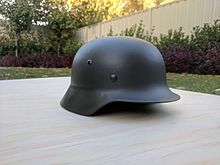
Stahlhelm (plural Stahlhelme) is German for "steel helmet". The Imperial German Army began to replace the traditional boiled leather Pickelhaube (spiked combat helmet) with the Stahlhelm during World War I in 1916. The term Stahlhelm refers both to a generic steel helmet, and more specifically to the distinctive (and iconic) German design.
The Stahlhelm, with its distinctive "coal scuttle" shape, was instantly recognizable and became a common element of military propaganda on both sides, just like the Pickelhaube before it. Its name was also used by the Stahlhelm, a paramilitary nationalist organization established at the end of 1918.
After the war, the German Bundeswehr continued to call their standard helmet Stahlhelm, but the design was based on the American M1 helmet. The Bundesgrenzschutz, however, continued to use the original German design, until either troop switched to the new M92 Aramid helmet.
Background
At the beginning of World War I, none of the combatants were issued with any form of protection for the head other than cloth and leather caps, designed at most to protect against saber cuts. When trench warfare began, the number of casualties on all sides suffering from severe head wounds (more often caused by shrapnel bullets or shell fragments than by gunfire) increased dramatically, since the head was typically the most exposed part of the body when in a trench. The French were the first to see a need for more protection—in late 1915 they began to issue Adrian helmets to their troops. The British and Commonwealth troops followed with the Brodie helmet (a development of which was also later worn by US forces) and the Germans with the Stahlhelm.
As the German army behaved hesitantly in the development of an effective head protection, some units developed provisional helmets in 1915. Stationed in the rocky area of the Vosges the Army Detachment "Gaede" recorded significantly more head injuries caused by stone and shell splinters than did troops in other sectors of the front. The artillery workshop of the Army Detachment developed a helmet that consisted of a leather cap with a steel plate (6 mm thickness). The plate protected not only the forehead but also the eyes and nose.
Origin

The design of the Stahlhelm was carried out by Dr. Friedrich Schwerd of the Technical Institute of Hanover. In early 1915, Schwerd had carried out a study of head wounds suffered during trench warfare and submitted a recommendation for steel helmets, shortly after which he was ordered to Berlin. Schwerd then undertook the task of designing and producing a suitable helmet, broadly based on the 15th-century sallet, which provided good protection for the head and neck.
After lengthy development work, which included testing a selection of German and Allied headgear, the first Stahlhelms were tested in November 1915 at the Kummersdorf Proving Ground and then field tested by the 1st Assault Battalion. Thirty thousand examples were ordered, but it was not approved for general issue until New Year of 1916, hence it is most usually referred to as the "Model 1916". In February 1916 it was distributed to troops at Verdun, following which the incidence of serious head injuries fell dramatically. The first German troops to use this helmet were the stormtroopers of the Sturm-Bataillon Nr. 5 (Rohr), which was commanded by captain Willy Rohr.
In contrast to the Hadfield steel used in the British Brodie helmet, the Germans used a harder martensitic silicon/nickel steel. As a result, and also due to the helmet's form, the Stahlhelm had to be formed in heated dies at a greater unit cost than the British helmet, which could be formed in one piece.
Models
The different Stahlhelm designs are named for their year of introduction. For example, the Modell 1942 which was introduced in 1942 is commonly known as M1942 or simply M42. Here, they are referred to by their M19XX names.
M1916 and M1917

The Stahlhelm was introduced into regular service during the Verdun campaign in early 1916.
The M1916 design had side-mounted horn-like ventilator lugs which were intended to be support for an additional steel brow plate or Stirnpanzer, which only ever saw limited use by snipers and trench raiding parties, as it was too heavy for general use.
The shell came in different sizes, from 60 to 68, with some size 70s reported. Helmet weight varied from 0.98 kg to 1.4 kg, depending on shell size. The suspension, or liner, consisted of a headband with three segmented leather pouches, each holding padding materials, and leather or fabric cords could be adjusted to provide a comfortable fit. The one-piece leather chin strap was attached to the shell by M1891 chinstrap lugs, the same kind used in the Pickelhaube helmet.
The M1916 design provided excellent protection: Reserve Lieutenant Walter Schulze of 8th Company Reserve Infantry Regiment 76 described his combat introduction to the helmet on the Somme, 29 July 1916:
"... suddenly, with a great clanging thud, I was hit on the forehead and knocked flying onto the floor of the trench... a shrapnel bullet had hit my helmet with great violence, without piercing it, but sufficiently hard to dent it. If I had, as had been usual up until a few days previously, been wearing a cap, then the Regiment would have had one more man killed."
But the helmet was not without its flaws. The ventilator horns often let cold air in during the winter, requiring the wearer to block the vents with mud or fabric. The large, flared skirt tended to make it difficult for soldiers to hear, distorting surrounding sounds and creating an echo when the wearer spoke.
Originally painted Feldgrau (field grey), the Stahlhelm was often camouflaged by troops in the field using mud, foliage, cloth covers, and paint. Official issue cloth covers in white and grey appeared in late 1916 and early 1917. Camouflage paint was not formally introduced until July 1918, when German Army Order II, No 91 366, signed by General Erich Ludendorff on 7 July 1918, outlined official standards for helmet camouflage. The order stipulated that helmets should be painted in several colors, separated by a finger-wide black line. The colors should be relevant to the season, such as using green, brown and ochre in summer.
After the effectiveness of the M1916 design was validated during the 1916 campaigns, incremental improvements were subsequently made. The M1917 version saw improvements to the liner, but was otherwise identical to the original design.
M1918

Extensive redesigns were made for the M1918 model. A new two-piece chin strap was introduced, and was attached directly to the helmet liner rather than the shell. Certain examples of the M1918 had cutouts in the rim along the sides of the helmet. It has incorrectly been said that these cutouts were to accommodate using headphones while wearing the helmet. These cutouts were actually done to improve hearing and to reduce echo created by the large, flared skirt.
The M1918 Stahlhelm can be distinguished from the M1916, as the M1918 shell lacks the chinstrap rivet on the lower side of the helmet skirt found on earlier models.
Austro-Hungarian variants


Austria-Hungary purchased about 416,000 German helmets from November 1916 until the end of the war and also began its own licensed production starting in May 1917. Around a million Stahlhelms of all variants were issued until the end of the war.
Austrian M17
The Austrian M17 helmet was similar to the German M16, but was colored golden-brown (known as Isonzo-braun), had a cloth chinstrap and had the chinstrap rivet located higher up on the steel shell. From May 1917 till the end of World War I 534,013 were produced, many of which were manufactured at the Krupp in Berndorf, Lower Austria. Other production locations included:
- Adolf Westen factory Celje, present day Slovenia
- Brunn am Gebirge, present day Austria
- C. A. Scholtz Mateocz, present day Slovakia
- Bruder Lapp, Rottenman u. Warcholowsky
- Nădrag, present day Romania
- Reșița, present day Romania
- Gebruder Bohler & Co. in Kapfenberg, present day Austria.
Hungarian M18
The Hungarian M18 variant was similar to the Austrian M17 design, but the chinstrap rivet was smaller in size and located even higher up than the Austrian version. It was colored in golden-brown (known as Isonzo-braun). These were manufactured at the Krupp in Berndorf, Lower Austria.
Berndorfer variant
There was also a quite different, domestically developed Berndorfer variant. 139,968 were produced from May till November 1917 at the Krupp in Berndorf, Lower Austria
Ottoman variant
Germany delivered 5,400 visorless versions of the M1918 helmet for the Ottoman Empire. The missing front visor was thought by the Germans to be for religious reasons, and it was claimed that it was to allow Turkish soldiers to touch their foreheads to the ground during prayer, without removing their helmets. However, this story has been disputed. The Turks rejected any more than the 5,400 delivered and an unknown number from the overrun were issued to German armed forces and were used by German Freikorps units after the war.
M1933


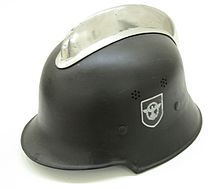
In 1932 the Army High Command ordered the testing of a new prototype helmet intended to replace the older models. It was made entirely from a composite plastic material called "Vulkanfiber". The Model 1933 Vulkanfiber helmet kept the basic form of previous helmets, but was much lighter. It was put into limited production following favourable field tests in early 1933 and small numbers were issued to Reichswehr infantry, artillery and communications units. It was removed from service following the introduction of the M1935 helmet and most of the remaining stock were reissued to civil organizations such as fire brigades and police forces. Some examples were also retained for parade use by senior officers, who were not generally issued with the Stahlhelm.
M1935

In 1934 tests began on an improved Stahlhelm, whose design was a development of World War I models. The Eisenhüttenwerke company of Thale carried out prototype design and testing, with Dr. Friedrich Schwerd once again taking a hand.
The new helmet was pressed from sheets of molybdenum steel in several stages. The size of the flared visor and skirt was reduced, and the large projecting lugs for the obsolete armor shield were eliminated. The ventilator holes were retained, but were set in smaller hollow rivets mounted to the helmet's shell. The edges of the shell were rolled over, creating a smooth edge along the helmet. Finally, a completely new leather suspension, or liner, was incorporated that greatly improved the helmet's safety, adjustability, and comfort for each wearer. These improvements made the new M1935 helmet lighter, more compact, and more comfortable to wear than the previous designs.
The Army's Supreme Command within the Third Reich's Wehrmacht combined armed forces officially accepted the new helmet on June 25, 1935 and it was intended to replace all other helmets in service.

More than 1 million M1935 helmets were manufactured in the first two years after its introduction, and millions more were produced until 1940 when the basic design and production methods were changed.
Civil defense variant

In 1938, the Germans developed a variant of the Stahlhelm with a wider, flared peak and ventilation holes originally intended for firefighters, civil defense, Reichsarbeitsdienst, and Luftschutz personnel. Known as the gladiator pattern, the privately purchased Luftschutz helmet was originally made from three pieces of steel and typically painted black or dark blue. Later in the war these were issued to Volkssturm personnel, and sometimes repainted in Feldgrun. By 1944, the helmets were stamped from a single steel sheet, and the original cloth lining replaced with vinyl to reduce costs. Due to the relatively small number produced, original helmets from the war years are considered rare. However, a modified postwar version in fluorescent green, white or yellow continued to be issued to rescue workers in the Bundesrepublik until the early 1990s.
M1940
The M1935 design was slightly modified in 1940 to simplify its construction, the manufacturing process now incorporating more automated stamping methods. The principal change was to stamp the ventilator hole mounts directly onto the shell, rather than utilizing separate fittings. In other respects, the M1940 helmet was identical to the M1935. The Germans still referred to the M1940 as the M1935, while the M1940 designation were given by collectors.
Fallschirmjäger version

A variant of the M1935 helmet with a shell lacking the projecting visor and deep, flared rim was issued to Fallschirmjäger (German paratrooper) units. It was so designed in order to lessen the risk of head injury on landing after a parachute jump; also to reduce the significant wind resistance and resulting neck trauma. Early Fallschirmjäger helmets were manufactured from existing M1935 helmets by removing the undesirable projections, which were omitted when the new design entered full production. The modified shell also incorporated a completely different and more substantial liner and chinstrap design that provided far more protection for German airborne troops. The chinstrap featured a four-point retention system that has come into use again by modern combat helmets such as the MICH since the late 1990s.
M1942
The M1942 design was a result of wartime demands. From direct orders of the Fürher, to ‘maintain intimidation but reduce cost’. The rolled edge on the shell was eliminated, creating an unfinished edge along the rim. This edge slightly flared out, along the base of the skirt, reducing the protection the helmet gave. The elimination of the rolled edge expedited the manufacturing process and reduced the amount of metal used in each helmet. Shell paint colors were typically matte grey-green (Heer) or grey-blue (Luftwaffe), and the decals were eliminated in 1943 to speed up production and reduce the helmet's combat visibility. Greater manufacturing flaws were also observed in M1942 helmets made late in the war.
M1944
A simpler variant, designed in 1942 by the Institute for Defense Technical Materials Science in Berlin, was also stamped out of one piece of metal, but with sloped sides. It was similar in appearance to the British 1944 Type Mk III helmet. Allegedly it was personally rejected by Hitler as being too foreign.
M1945
There have been reports of a variant manufactured in the last months of the war. The M1945 was reported to have been similar to the M1942 design, but did away completely with the ventilator. These helmets are reported to be extremely rare. Many collectors and historians are of the opinion that the M1945 helmet is either just a regular M1942 helmet that lacked the vents simply because of machine malfunctions in the factory, or unfinished M1942 that were completed in the post-war era.
M1954
A variant of the M1944 with a modified suspension system, developed further into the M1956.
M1956

The East German M-56 helmet was originally designed in 1942 as a replacement for the M1935/M1940 model Stahlhelm. It was initially developed for the Wehrmacht by the Institute for Defense Technical Materials Science in Berlin (see M1944 above). The helmet had seen trials since 1943, but was not adopted during World War II.
The design was not used until the requirement for a distinct German helmet for the Volkspolizei and the National People's Army arose. The East German leadership was motivated in large part by a desire to avoid provoking the offence that using a traditional Stahlhelm design would have caused East Germany's Warsaw Pact allies (especially Czechoslovakia, Poland and the Soviet Union), but a more practical military necessity was also present due to the continued use of surplus Stahlhelms by West German units, in particular border guards. Moreover, the East Germans suspected the West could re-issue the Stahlhelm on a general basis in the Bundeswehr at any time and therefore needed a helmet that was easily distinguishable from that of their potential enemy. For both reasons, the 1942 design was likely chosen because it was the most similar of all German designs to the most recognizable Soviet helmets, in particular the iconic SSh-40 design. Such a design not only served a political purpose, but was one that NATO armies were unlikely to closely duplicate. Indeed, the M-56 was similar enough in appearance to the SSh-40 that some Westerners failed to realize its German origins altogether and assumed the East Germans had adopted a Soviet design.
The M-56 helmet came in three basic versions, Mod 1 or I/56, Mod 2 or I/57 and Mod 3 or I/71, and was widely sold (or given) to Third World armies.
The West German M-56 Stahlhelm was a direct copy of the U.S. M1 helmet. It was properly called "zweiteiliger Stahlhelm" (two-piece steel helmet). In 1958 the helmet was made as a one-piece helmet and renamed Stahlhelm M1A1. The M1A1 came in three sizes: 66, 68, and 71. This helmet was used until 1981 when a modified version was released and renamed the Helm1A1. Modifications included a 3-point chin strap with the third point connecting at the nape, extra large sizes, and a further adjustable liner.
The M1A1 Stahlhelm remained in service until 1992 when the Bundeswehr replaced it with a PASGT-derived kevlar helmet called the Gefechtshelm ("Fighting helmet").
Decals and insignia

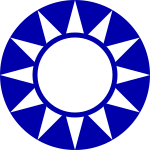

After Stahlhelm shells were painted, the colours of which varied by organization, small identification or insignia decals usually were affixed to one or both sides of the helmet. Almost every military, naval, and political organization had its own distinctive insignia, which was applied as decals to the sides of helmets. The right side of early M35 helmets bore the tricolored shield of black, white, and red stripes, the traditional national colors of Imperial Germany (cf. the black, red, and gold of today's Germany, harking back to the 1848 Revolt). The left side of the shell often received decal insignia denoting the branch of the armed forces, or Wehrmacht, or an organization within the Nazi Party.
The combined Wehrmacht military forces of Nazi Germany consisted of the Heer (army), the Kriegsmarine (navy), and the Luftwaffe (air force). While not technically part of the Wehrmacht, the Waffen-SS ("Armed-SS") tactically operated as such and was considered part of Germany's armed forces during the war. The same was true of some Sturmabteilung (SA) units, along with other subsidiary organizations, which functioned as part of the armed forces particularly towards the end of the war. Wehrmacht branches typically displayed distinctive emblems in the form of decals on their helmets. The Heer, or army, displayed a black shield bearing the frontal view of a silver-colored German eagle holding a swastika in its talons (known as the Reichsadler), while the navy used the same eagle emblem in gold. Luftwaffe decals displayed the side view of an eagle in flight, also holding a swastika. The SS was both a paramilitary and a political organization, and its black runic initials on a silver-colored shield (normally applied to the right side of the shell) looked like twin lightning bolts. Other military, political, and civil or defense organizations used similar decal insignia to distinguish their helmets. Such visible identification devices were gradually abandoned as the war progressed, however, so that by war's end most Wehrmacht helmet insignia had been eliminated to reduce the wearer's visibility in combat.
For the Chinese Nationalist Army soldiers, their M35 helmets were printed with the Chinese Nationalist Insignia in both sides.
Stahlhelm use in other countries



Germany exported versions of the M1935 helmet to various countries. Versions of the M1935 Stahlhelm were sent to Republic of China from 1935 to 1936 and M1935 helmet was the main helmet of the Chinese Nationalist Army during World War II. Spain also received shipments of the helmet. During the inter-war years several military missions were sent to South America under the command of Hans Kundt, after Chaco War the Bolivian army used to wear the helmet up until recently. The exported M1935 helmets were similar to the German issue, except for a different liner.
Some countries manufactured their own helmets using the M1935 design, and this basic design was in use in various nations as late as the 1970s.
The Germans allowed and assisted the Hungarians in copying their design of the M1935 steel helmet. Therefore, the WWII-produced M38 Hungarian steel helmet is nearly identical to the German M1935. Both have the same shape, riveted ventilation holes, and the classic rolled edge. Differences include a different liner and different rivets position - the cotter pins are situated behind the ventilation holes. A square metal bracket is riveted on the rear, above the back brim; used to secure the helmet to the knapsack while marching. It was typically painted in Hungarian brown-green, albeit blue-grey versions existed. It is sometimes called the "Finnish M35" due to their extensive use by the Finnish Army during the Continuation War 1941-44.
After the end of World War I Poland seized large quantities of M1918 helmets. Most of those were later sold to various countries, including Spain. However, at the end of the 1930s it was discovered that the standard Polish wz. 31 helmet was unsuitable for tank troops and motorized units; while offering decent protection, it was too large and heavy. As a stop-gap measure before a new helmet was developed, the General Staff decided to issue M1918 helmets to the 10th Motorized Cavalry Brigade, which used them during the Polish Defensive War.
During the time of the Warsaw Uprising the helmet was also worn by the members of the Polish Home Army and it was during this time that the helmet became the symbol of the resistance, as every Stahlhelm worn by the soldier of the underground army signified a dead German occupier it was taken from.
During the inter-war years, the Irish Defence Forces equipped its troops with a copy of the M1918 helmet manufactured by Vickers. At the outbreak of World War II, Ireland remained neutral, but in 1940 Ireland's rapidly expanding Army replaced this helmet with British-style helmets as Vickers had stopped manufacturing the helmet. Switzerland used a helmet, designated the M1918, that was roughly similar to the M1916, but had a shallower, wider and more rounded crown and skirt. This was to protect against the harsh winter winds of the alpine regions.
The Chilean Army was a prolific user of the Vulkanfiber models, bought before the Second World War, along with a few M1935 and Czechoslovak M1932 helmets. After the war, local production started, with plastic models still in ceremonial & garrison use today. Small runs of steel helmets were made by FAMAE in the 80's, but ultimately were not adopted due to the ascendance of kevlar helmets by that time . A Stahlhelm with crossed bayonets and the corresponding number is the standard insignia of infantry regiments.
The Argentine Army adopted a similar model, made of pressed fiber, during World War II, reflecting the traditional sympathy towards Germany found in many of the officers. For combat use, imported Swiss M1918 helmet were used up until the 1960s.
In the Socialist Federal Republic of Yugoslavia, due to large quantities captured by World War II Partisans, the Stahlhelm was used in Yugoslav People's Army up to 1959, when it was phased out and replaced by the M59/85 steel helmet.
Postwar
After World War II, West Germany's Bundesgrenzschutz border guards and some West German police units kept the Stahlhelm in their inventories (police units can be seen wearing them during footage of the Black September hostage crisis in 1972), and the Fallschirmjäger variant was used for some time by the GSG 9. With the re-armament of West Germany the Bundeswehr introduced the United States Army M1 Helmet which was replaced by a Kevlar helmet (Gefechtshelm), similar to the modern US helmets, in the 1990s. German firefighter units today still use Stahlhelm-shaped helmets in a fluorescent color.
East Germany's National People's Army M-56 helmet was modelled on an unused 1942 German design with a more conical shape. The Chilean Army still uses the Stahlhelm design for ceremonial purposes, as well as the Bolivian Army. There are also some Japanese bicycle helmets (with accompanying goggles) that resemble the Stahlhelm.
The U.S. Army's 1980s and 1990s era Kevlar Personnel Armor System for Ground Troops Helmet was sometimes called the "Fritz helmet" for its resemblance to the Stahlhelm. The U.S. Army and Marines have continued to use a design akin to the PASGT helmet with the MICH TC-2000 Combat Helmet and Lightweight Helmet, respectively.
The Chinese People's Liberation Army soldiers still used M1935 helmets which were captured from the Chinese Nationalist Army during the Chinese Civil War until the 1970s.
Since 2012, El Salvador's Policia Nacional Civil use a navy/indigo blue-colored helmet that strongly rembles the Stahlhelm; this helmet is used by some members of the riot-control unit and rarely used by the Police's assault teams.
-
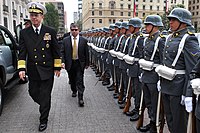 Chilean honor guard next to U.S. Admiral Michael G. Mullen in March 2009
Chilean honor guard next to U.S. Admiral Michael G. Mullen in March 2009
-
 German firefighting helmet
German firefighting helmet
-
 Argentinian army use of the Swiss M1918 helmet, 1930s-1940s
Argentinian army use of the Swiss M1918 helmet, 1930s-1940s
-
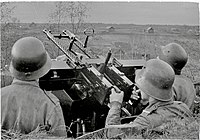 Finnish AA-MG crew in 1942. The soldier in the middle has a German M1916 and other two have Hungarian M38 helmets
Finnish AA-MG crew in 1942. The soldier in the middle has a German M1916 and other two have Hungarian M38 helmets
-
 German Civil defense stahlhelm with wider, flared peak in use from the 1940s until the 1990s
German Civil defense stahlhelm with wider, flared peak in use from the 1940s until the 1990s
-
Ukrainian Euromaidan protester wearing stahlhelm, 2014. The inscription says "Putin, think or you'll end up like Hitler".
Users
| This section needs expansion. You can help by adding to it. (December 2016) |
- Germany
 German Empire(M1918)
German Empire(M1918) Nazi Germany(M35~M42)
Nazi Germany(M35~M42) East Germany(M56)
East Germany(M56) West Germany(For Bundesgrenzschutz use, copies of M35)
West Germany(For Bundesgrenzschutz use, copies of M35)
- Austria
- As part of
 Nazi Germany
Nazi Germany  Austria-Hungary
Austria-Hungary
- As part of
- China
- Turkey
 Ottoman Empire
Ottoman Empire Kingdom of Italy
Kingdom of Italy Kingdom of Hungary
Kingdom of Hungary Kingdom of Afghanistan
Kingdom of Afghanistan Finland
Finland Estonia (M16-18)
Estonia (M16-18) Greece (limited use by EAM-ELAS Communists)
Greece (limited use by EAM-ELAS Communists) Spain
Spain Yugoslavia
Yugoslavia Belgium
Belgium Czechoslovakia
Czechoslovakia Colombia
Colombia Chile
Chile Bolivia
Bolivia Norway
Norway Sweden
Sweden Argentina (M1918 in use as late as December 1975)
Argentina (M1918 in use as late as December 1975) Latvia (M1918)
Latvia (M1918) Lithuania (M1918)
Lithuania (M1918) Netherlands (Netherlands East-Indies Army, KNIL and local police forces)
Netherlands (Netherlands East-Indies Army, KNIL and local police forces) Indonesia (captured from the Dutch or bought from the Chinese or produced in a small factory in Surabaya)
Indonesia (captured from the Dutch or bought from the Chinese or produced in a small factory in Surabaya) Poland (mostly captured from the Germans by Armia Krajowa partisans)
Poland (mostly captured from the Germans by Armia Krajowa partisans) Tunisia (used by National Guard in 60s and spotted in Battle of Ben Guerdane picture of tunisian national guard officer wearing stahlhelm )
Tunisia (used by National Guard in 60s and spotted in Battle of Ben Guerdane picture of tunisian national guard officer wearing stahlhelm ) Independent State of Croatia
Independent State of Croatia
See also
Notes
- "WWII equipment of the Bundesgrenzschutz". wwiiafterwwii.wordpress.com. 10 April 2016. Retrieved 14 May 2018.
- Suciu, Peter (2 February 2009). "The first modern steel combat helmet: the French 'Adrian'". Military Trader. Retrieved 13 April 2014.
- "Infantry Helmets". Militaryheadgear.com. 1 January 2008. Retrieved 13 April 2014.
- "German Spare Parts". jonsmith-modellbau.com. Retrieved 26 November 2016.
- "WKI Gaede Stahlhelm". zib-militaria.de. Retrieved 26 November 2016.
- Tubbs & Clawson (2000), p. 10.
- Tenner, Edward (Summer 2003). "Hardheaded Logic: The Helmet is older than the city-state and newer than the airplane". American Heritage. 19 (1). Archived from the original on August 28, 2008.
- Dunstan, Simon; Volstad, Ron (1984). Flak Jackets: 20th Century Military Body Armour. Osprey Publishing. p. 5. ISBN 0-85045-569-3.
- ^ Bull, Stephen; Hook, Adam (2002). World War I Trench Warfare: 1914–16. Osprey Publishing. pp. 10–11. ISBN 1-84176-198-2.
- Sheldon (2007), p. 219, quoted and translated from Gropp, History of IR 76, p.159.
- ^ Ortner, M. Christian (2002). The Emperor's coat in the First World War: Uniforms and equipment of the Austro-Hungarian army from 1914 to 1918. Vienna: Verlag Militaria. p. 141. ISBN 978-3-9501642-1-3.
- "About WWI & WWII German & Austro-Hungarian Helmets". Alexander & Sons Restorations. Archived from the original on 7 July 2015. Retrieved 26 November 2016.
{{cite web}}: Unknown parameter|deadurl=ignored (|url-status=suggested) (help) - Tubbs & Clawson (2000), p. 24.
- ^ Bell, Brian C.; Lyles, Kevin (2004). Wehrmacht Combat Helmets 1933-45. Osprey Publishing. p. 12. ISBN 1-84176-725-5.
- Hitler's auxiliaries
- Stahlhelm
- Picture of original helmet in dark blue
- Picture of Feldgrum Volkssturm helmet
- Volkssturm helmet
- M44 Luftschutz helmet
- German helmets
- "M35 Stahlhelm vs. M40 Stahlhelm". Helmet History. Luftm40. Retrieved 5 June 2013.
- Dunford, Jeffrey Lynn. "Weapons and Equipment of the Fallschirmjäger". Feldgrau.com. Retrieved 13 April 2014.
- ^ "World War II Combat Helmet Types". German-Helmets.com. Retrieved 13 April 2014.
- Hancock, M. Donald (1973). The Bundeswehr and the National People's Army: A Comparative Study of German Civil-Military Polity. University of Denver. p. 25.
- Smith, Digby George (1980). Army Uniforms Since 1945. Poole, England: Blandford Press. ISBN 9780713709919.
- Baer, Ludwig (1977). Die Geschichte des Deutschen Stahlhelmes: von 1915 bis 1945; seine Geschichte in Wort u. Bild [The history of German steel helmets: from 1915 to 1945; their story in words & pictures] (in German). Eschborn: L. Baer (Selbstverlag).
- ^ Tubbs & Clawson (2000), p. 80-81.
- Lucy, Roger (January 2015). ""Euroclones": An essential guide to postwar steel helmets". OCAD Militaria Collectors Resource. Retrieved 26 November 2016.
- "Collector Topics: Helmet Decals". German-helmets.com. Retrieved 13 April 2014.
- "Mº 35 de fibra". cascoscoleccion.com. Retrieved 14 April 2018.
- "Mº 35 de fibra". cascoscoleccion.com. Retrieved 14 April 2018.
- "Mº Alemán ejército (fibra)". cascoscoleccion.com. Retrieved 14 April 2018.
- "Mº 35 (FAMAE)". cascoscoleccion.com. Retrieved 14 April 2018.
References
- Sheldon, Jack (2007). The German Army on the Somme 1914–1916. Barnsley, South Yorkshire, UK: Pen & Sword Military. ISBN 978-1-84415-513-2. OCLC 72868781.
{{cite book}}: Invalid|ref=harv(help) - Tubbs, Floyd R.; Clawson, Robert W. (2000). Stahlhelm: Evolution of the German Steel Helmet (Revised and expanded ed.). Kent, Ohio: Kent State University Press. ISBN 9780873386777. OCLC 43706682.
{{cite book}}: Invalid|ref=harv(help) - Krause, Jürgen (1984). "Stahlhelme vom Ersten Weltkrieg bis zur Gegenwart" [Steel helmets from the First World War to the present] (PDF). Veröffentlichungen des Bayerischen Armeemuseums. Vol. 8 (in German). Special exhibition at Bayerisches Armeemuseum, Ingolstadt.
| Helmets | |||||||||||||||
|---|---|---|---|---|---|---|---|---|---|---|---|---|---|---|---|
| Individual historical helmets |
| ||||||||||||||
| Combat |
| ||||||||||||||
| Athletic | |||||||||||||||
| Work | |||||||||||||||
| Other | |||||||||||||||
| Austro-Hungarian infantry weapons and equipment of World War I | ||||||
|---|---|---|---|---|---|---|
| Sidearms |
| 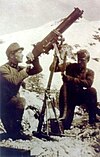 | ||||
| Rifles |
| |||||
| Hand grenades | ||||||
| Machine guns |
| |||||
| Helmets | ||||||
| Other equipment | ||||||